In mid-May 2008, my husband and I decided we wanted to spend Memorial Day weekend collecting geodes in the vicinity of Keokuk, Iowa. We had never gone geode collecting before, but we had heard stories of the famous Keokuk geodes, and wanted to try collecting some for ourselves and our gift shop in Kansas City.
As luck would have it, we did some online research to try to find the best places to collect geodes and we stumbled across the McRocks website. There we learned that a group of rockhounds were making plans to meet in Keokuk on Memorial Day weekend to go geode collecting. Jim E., who was heading up the geode trip, advised us via email that we were welcome to join the group, so following his recommendation, we made arrangements to stay at Hickory Haven Campground in Keokuk.
On Saturday, May 24, we met Jim E. and Teresa R. (both from Minnesota) at Hickory Haven Campground. From there, we traveled into Keokuk at 9 a.m. and rendezvoused with John and Christine (from the St. Louis area) at the River City restaurant on Main Street. Jim E., who was leading the group, had called the property owners to get permission for us to collect that weekend. He had also prepared an awesome map marked with the various collecting sites we would be visiting.
The six of us headed first to the Evans property in Hamilton, IL. The Evans were out of town, but they let us collect on their property with the understanding that someone in our group would collect money from our group for our filled buckets, and we would later send them a check. Our understanding was that all proceeds from the geodes at the Evans property go towards helping their son with his medical expenses. Anyone wishing to collect at this location should call in advance to make an appointment.
The collecting fee at the Evans property was $20 per 5-gallon bucket. You could dig in one of two ravines on either side of the house (as long as you stayed between the street and the swings), or you could help yourself to piles or milk crates full of pre-dug geodes (pictured below) at various places around the yard, sheds, or front porch.
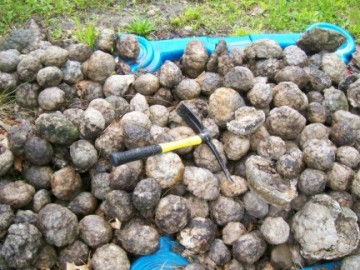
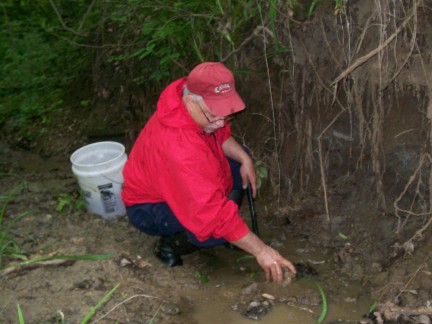
If you wish to dig in the ravines at the Evans property, you would be well advised to wear long sleeves and long pants, as the ravines had an abundant crop of poison ivy. (Since returning home, I have been to the doctor to combat the effects of this nasty little vine, and have yet to totally whip the sucker!) The creek area was very muddy, so rubber boots or wading shoes would also be a great idea, particularly if it has rained recently.(Jim E. pictured above, right) Even a pruner to cut back the vines where they overhang the banks or creek would have come in handy. Be advised, there are no public rest rooms at the Evans' property, so plan accordingly.
At the Evans property, we mostly found golf-ball to tennis-ball sized geodes. Many geodes felt heavy, and later cracking has revealed that many of them were solid quartz. However, those that were lighter weight did have some interesting cavities and formations of quartz, calcite, etc. After getting caught in a downpour at the Evans, we took a break for lunch and to dry off and warm up again.
At 1:00 p.m., we reconvened at Jacob's Geodes on County Road 1220 on the outskirts of Hamilton, IL. Gary, the property owner, came out to greet us and give us a few instructions. Signs at the entrance to the property clearly marked this as a spot open to the public for geode collecting. Due to recent rains, the creek that intersected the road to the geode mine was too high to drive across. Not to be deterred, we carefully navigated some stepping stones in the creek and made our way up the muddy pathway to the collecting site. It felt like each step of the way we added a pound of mud to the bottom of our shoes or boots. The hill was a little steep and very slick with mud, so rubber boots or shoes would have been a good idea that day.
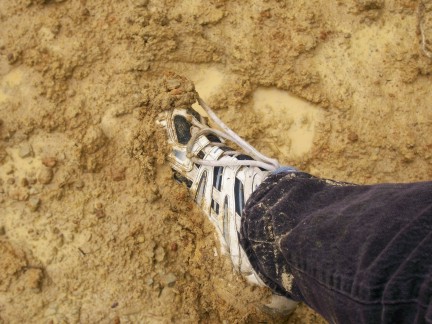
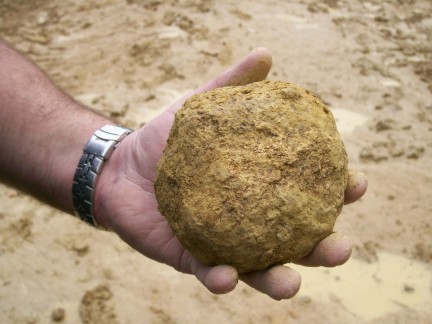
As we reached the excavated area, we could see multiple geodes varying in size from 1" in diameter to 5" or 6" in diameter scattered around the site. The geodes that had been exposed by previous diggers tended to be thick-walled and heavy; therefore not as likely to contain interesting cavities. To obtain the nicer, thinner shelled specimens, it was necessary to dig or chisel into the hardened clays or dirt embankments around the perimeter of the pit.
For digging at Jacob's Geodes, recommended tools include a pick ax, a chisel, and a hammer--and be sure to wear gloves if you want to avoid blisters! Many areas in the embankments contained clusters of geodes, so removing individual geodes was a challenge, as often they were found in close proximity to each other. Tiny, marble to quarter-sized geodes were abundant here. This delighted Teresa R., who was quickly adding to her "baby geode" collection. Golf ball to tennis-ball sized geodes were also fairly common. We also hit a few pockets of grapefruit sized geodes here. Rick R. of Kansas City had the best success unearthing grapefruit size geodes in softer dirt in the embankment near the road into the mine.
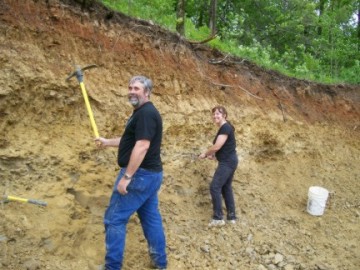
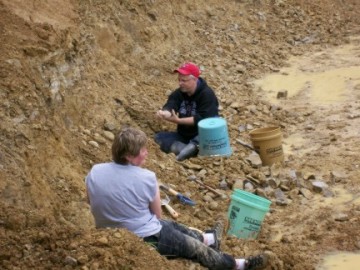
Jacob's Geodes location seemed to have more hollow geodes than the Evans site we had visited that morning. However, more "elbow grease" was needed to extract the geodes from the hardened clays. The fee to collect at Jacob's Geodes was only $16 per 5-gallon bucket, which was definitely a good value. His was the only site open to the public on a regular basis, but it is recommended that you still call to ensure the collecting site is open when you intend to visit.
The pit itself was surrounded by trees, but the digging areas at Jacob's Geodes were in full sun. Therefore, you may want to consider wearing a hat and/or sunscreen and packing along something cold to drink while collecting at this site. Jacob's Geodes location has an outhouse available, rustic as it may be.
After we finished collecting at Jacob's Geodes, Gary showed us his geode "store." It was actually a semi-trailer lined with tables and shelves of geodes (and other specimens) which were very reasonably priced.
Back at Camp later that evening, we met for a taco fest, then Jim E. set up his soil pipe cutter so we could have a geode cracking party. For several of us, this was our first time collecting, so the cracking party revealed our lack of experience in selecting the lighter, hollow geodes. However, about half of them had pretty cavities with quartz, calcite, and/or chalcedony formations.
Jim E. had arranged with Dennis Stevenson for our group to collect on his property on Sunday morning. (Anyone wishing to collect at this location should call in advance to make an appointment.) The Stevenson property was about 20 acres, thereby being the largest collecting site we visited that weekend. Dennis pointed out several potential collecting areas along the creek or at various spots around his property. Dennis was pleasant to visit with, and very helpful, offering to help us move our buckets back to our vehicles with his golf cart, if needed. As he showed us one of his recommended digging areas along the tree roots near a creek, he quickly dug out about a 9" diameter geode. That definitely gave us motivation to start digging!
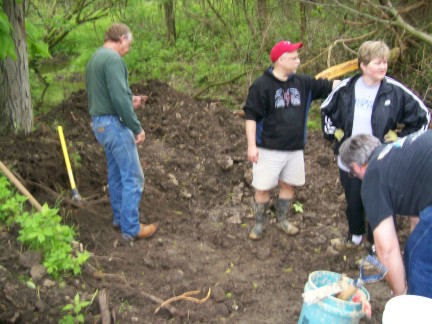
After spending a long, hard day excavating geodes on Saturday, our group was somewhat tuckered out when it came to digging at the Stevenson property on Sunday. We worked the embankments along the creek , and unearthed some sizeable (4"-10") geodes. Quite a few were heavy, but some of the 4"-6" size felt hollow. What was nice about this collecting area is the ground around the geodes was relatively soft, so extraction was easier than at the sites we visited on Saturday.
Dennis also took the time to demonstrate his hydraulic pipe cutter which he uses to crack large geodes. As he demonstrated this tool, it was obvious a hydraulic cutter is a "must have" for the hard-core geode enthusiast. It eliminated most of the hard work involved in using manual pipe cutters to crack geodes. Dennis offered to use his tool to crack the larger geodes we had collected (for a small fee). Dennis also had available a couple of extra hydraulic soil pipe cutters for purchase, so be sure to ask him about them if you are interested.
The collecting fee at the Stevenson property was $16 per 5-gallon bucket. As the geodes here were sizeable, good quality, relatively hollow, and easier to extract than at other sites, his fees seemed very reasonable. Below are some photographs of 6" - 10" geodes Dennis found on or near his property:
Sunday afternoon we met up with Randy and Kathy Arvis, owners of the Hill Top Mud Bog, at their fireworks stand off of Highway 27 in St. Francisville, MO. Several huge geodes (10"-20" diameter) were on display at the fireworks stand which the Arvises had collected from their property. The fee to collect at the Arvis' site was $25 per bucket. (Anyone wishing to collect at this location should call in advance to make an appointment.) This collecting site was the only one of the four locations we visited which had a per-pound fee for geodes which were too large to fit in a bucket.
Randy led the way down a dirt road through his woods to an open excavation area where several 10"-18" geodes could be seen on top of or sticking out of heaps of dirt and shale. Of the four sites, The Arvis' site was by far the smallest in terms of the collecting area. Jim E. indicated, however, that Arvis' geodes were very similar to those prized monster geode specimens extracted from the Area C-61 site.
The afternoon suns were starting to beat down intensely, so by this point most of our group was too exhausted to do much digging. We collected some 5"-12" geodes at this location and asked Randy to crack them open to see the quality of geodes at his site. We hadn't been as careful picking geodes as we might have been under cooler temperatures or with a fresh burst of energy. However, all things considered, about half of the geodes had some nice cavities.
It was obvious that the largest geodes we had seen that Memorial Day Weekend were to be found in St. Francisville. With more effort and careful selection, I believe we could have collected some very nice, hollow specimens. Some smaller geodes were also in the mounds of dirt and shale, but just as many basket-ball sized and up appeared to be available for the determined collector. A bigger percent of the geodes smaller than 5" in diameter seemed to be more hollow and have the prettier cavities. Smaller geodes, however, were much less abundant.
Randy was more than willing to help load our buckets into his trailer and pull them with his ATV up the hill to our waiting vehicles. Randy also had a ratchet and gear-driven soil pipe cutter which he and Rick R. used to crack open the larger geodes (for a fee). Even with Randy's special tools, some of the geodes were nearly impossible to crack. Both Randy and Rick were pretty exhausted by the time they had cracked open about 18 geodes.
Afterwards, Randy showed us one of his prize geodes found on his property.
We bade farewell to Jim E. and Teresa R., who were kind enough to show us the collecting sites that weekend. They headed back to Minnesota, and we returned to Hickory Haven Campground for one final night of camping. Despite the rains and tornado watch that evening, we stayed dry within our tent and survived the wild weather.
On Wednesday, the Wheeler soil pipe cutter I was lucky enough to purchase on ebay for $95 showed up via Fedex home delivery. We once again had a geode cracking party of our own, and were pleased to see many of our smaller geodes (1½" - 3") yielded pretty quartz, chalcedony and calcite formations.
Note: While in Keokuk, be sure to visit the Holiday Inn Express on Main Street. It has an interesting Keokuk geode collection on display. The geode collection is dedicated to the memory of Glen & Bertha Bevard, former owners of Keosippi Lapidary on South 7th Street.